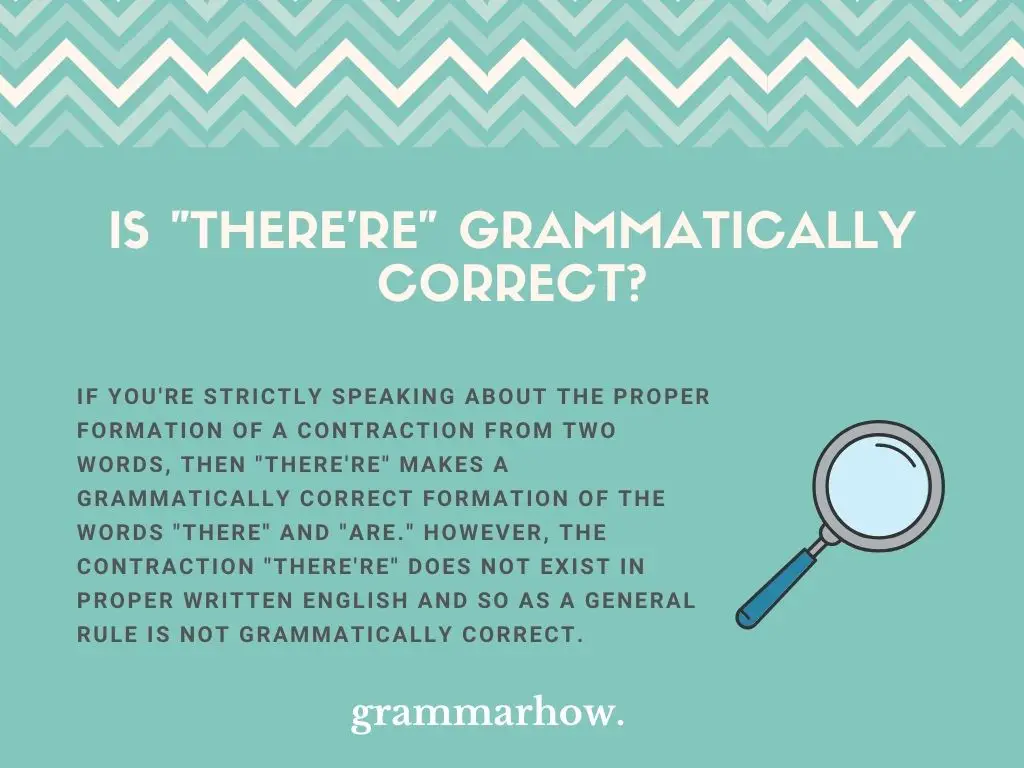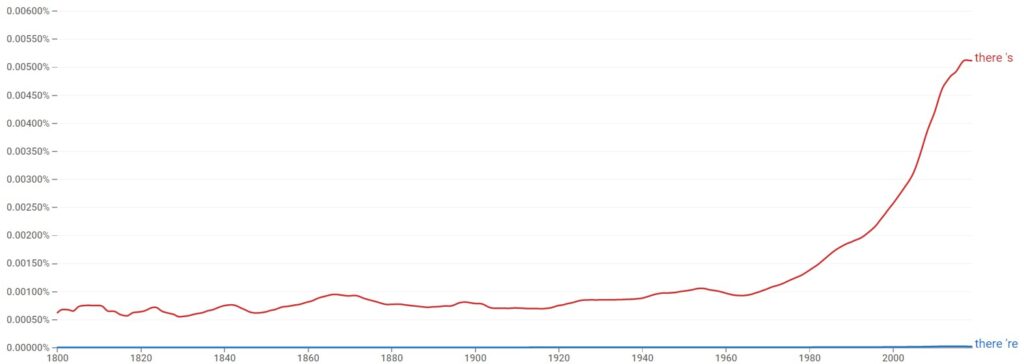Contractions, although simple on the surface, can sometimes be confusing. The fundamental rule to drop the vowel and add an apostrophe to combine two words seems basic enough, but the word “there’re” has many asking if it is grammatically correct to use or should be used at all. Continue reading to find out.
Is “There’re” Grammatically Correct?
If you’re strictly speaking about the proper formation of a contraction from two words, then “there’re” makes a grammatically correct formation of the words “there” and “are.” However, the contraction “there’re” does not exist in proper written English and so as a general rule is not grammatically correct.

There are, of course, instances where you encounter “there’re” being used. Generally, you will see this contraction used mostly in informal spoken English rather than in the written word.
The main purpose of a contraction is to shorten the number of syllables spoken or read by combining two words into a shortened form of one word. “There’re” does not meet this requirement because it has the same number of syllables as saying “there are.” So, it defeats the purpose.
Is “There’re” Grammatically Correct According To Dictionaries?
Let’s look at whether different popular dictionaries recognize the word “there’re” or not.
A search in The Cambridge English Dictionary refers you to several other variations of the word “there” and does not have a specific entry for the word “there’re,” suggesting that it does not recognize it as a valid word.
Similarly, the Merriam-Webster Dictionary provides these results as well. A search here returns the text that reads “The word you’ve entered isn’t in the dictionary. Click on a spelling suggestion below or try again using the search bar above,” indicating that it also does not recognize the word.
The same result holds true in The Oxford Learner’s Dictionary.
Two online dictionaries where you can find a definition for the word “there’re” are The Urban Dictionary, which defines it as “colloquial contraction of there are,” and the British version of The McMillian Dictionary which simply defines it as “there are.”
Given that The Urban Dictionary is not a well-recognized source for proper written English language, but rather a dictionary of “slang” terms, you can determine that the word “there’re” is not universally recognized by scholars as a valid word. Rather, it is an informal phrase only.
Examples Of How To Use “There’re” In A Sentence
If you wish to use the word “there’re” in a sentence, make sure that you only use it to replace the words “there” and “are” and that if you insert those two words instead, it does not change the meaning of the sentence.
Here are some examples showing “there’re” properly used in a sentence.
- There’re more clean towels in the closet down the hall if you run out.
- There’re oranges on the counter if you get hungry.
- There’re 10 people coming over for dinner tonight, we need to make sure the house is clean.
See how in each of these sentences the word “there’re” could easily be replace with “there are.”
How Prevalent Is The Use Of “There’re” Compared To “There’s”?
Often, instead of saying “there’re” or “there are,” people just say “there’s,” regardless if the noun following is singular or plural. This variation would seem grammatically incorrect based on the rules, but in many dialects it is universally understood and acceptable.
Let’s look at the prevalence of using “there’re” compared to “there’s.”
From the Google Ngram Viewer chart you can see that instances of “there’re” were widely not found at all from the 1800s up until today.

In contrast, the use of “there’s” remained steady, but still rather low, from 1800 until about the 1960s, when it started an upward climb in popularity.
As of 2019, the use of “there’s” has jumped sharply, suggesting that over time it has been adopted as a well-known and widely-used term meaning both “there is” and “there are.” The jump seems to have particularly begun in the 1980s, so it is more modern.
Why Is “There’s” Used More Than “There’re”?
The purpose of contractions is that they serve to shorten the amount of syllables that needs to be said when combining two words. The word there’re” does not accomplish this goal, whereas the word “there’s” does, which suggests why it would be more widely used and accepted.
Also, if you say both of the contractions out loud, you will clearly notice that “there’s” seems to run more smoothly off the tongue than “there’re.” You almost have to pause and think about saying “there’re,” whereas saying “there’s” just comes naturally.
Perhaps this fact has to do with the data we saw in the Google Ngram Viewer above, which showed how we are clearly more used to reading (and hearing)the phrase “there’s”, especially in modern times.
Is It Recommended That I Use “There’re” As A Contraction For “There Are”?
Based on the analysis from this article, you can safely assume that it is not recommended to use “there’re” as a contradiction in most cases, especially in written word. The exception might be if you are writing something that includes dialogue of a certain dialect or a character with a certain informality in speaking.
If you are writing a formal paper or document and want to ensure that it is grammatically correct, you should always write out the full phrase “there are” when the noun to which you are referring to is plural.
Some examples include:
- There are 12 fish in the tank and the blue one is my favorite.
- There are three weeks until vacation and I can’t stop daydreaming about my trip.
- There are five people who can’t make the party so I will have to adjust the seating chart accordingly.
Notice how these sentences still make sense if you use the word “there’s” instead of “there are,” but do not sound right if you use the phrase “there is” in its place.
Let’s look at them both ways:
- Correct: There’s 12 fish in the tank and the blue one is my favorite.
- Incorrect: There is 12 fish in the tank and the blue one is my favorite.
- Correct: There’s three weeks until vacation and I can’t stop daydreaming about my trip
- Incorrect: There is three weeks until vacation and I can’t stop daydreaming about my trip.
- Correct: There’s five people who can’t make the party so I will have to adjust the seating chart accordingly.
- Incorrect: There is five people who can’t make the party so I will have to adjust the seating chart accordingly.
When you break the contraction “there’s” into two separate words, you can clearly see that it doesn’t make sense in the context of a plural subject.
